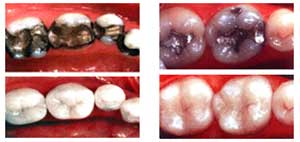
Tooth-colored fillings were created as an alternative to traditional metal dental fillings. Tooth fillings colored to look like a natural tooth are known as Composite Resin Dental Fillings and are made of a plastic dental resin combined with porcelain and glass particles. These types of fillings are, durable and are way more natural looking than amalgam fillings. If you have a cavity in a tooth or broken fillings or if your teeth are full of mercury fillings, or amalgam fillings you may want to ask your dentist about changing to Tooth-colored fillings. Mercury fillings or amalgam fillings can easily be removed and replaced with far more attractive colored fillings. Research shows that composite fillings actually strengthen your tooth and further protect it from decay. Tooth-colored fillings are a safer and more attractive alternative to older silver amalgam fillings. By precisely matching tooth-colored composite fillings with the natural color of your teeth, a skilled cosmetic dentist is able to provide you with white fillings that are virtually invisible. The removal of amalgam fillings can provide patients with white fillings that provide a more pleasing, silver-free smile.
Tooth colored fillings
The most popular kind of 'white filling' is called a Composite filling. It is made up of a composite quartz resin (glass and porcelain) and usually contains some sort of light sensitive agent that is used during curing. They are an attractive, durable alternative to silver (amalgam) fillings. In the past, white fillings were placed only on front teeth, but recently these composite materials have been specifically designed to be able to survive the pressure of grinding when you chew. These light cured composites are best looking and in most cases they can be inserted in one appointment.
Porcelain inlay or onlay
This is used when cosmetics and wear resistance is most important for a patients. A porcelain inlay or onlay is used when the cavity is too big for a filling, but isn't so big that a crown is required. An inlay is a filling within the cusp tips of the tooth. Onlays (also known as overlays) will overlay one or more cusps in order to protect and strengthen the tooth. This type of filling costs about the same as an indirect composite inlay/onlay and takes two visits.
Gold inlay or onlay
An inlay or onlay may also be made of gold. Gold fillings despite being expensive, have long history of use with excellent durability, wear well, and do not cause excessive wear to the opposing teeth. But they do conduct heat and cold making its presence felt in the mouth. Recent advances has brought consumer focus on aesthetic results of composites and porceelain veneers and crowns.
Glass Ionomer
This is considered fairly conservative procedure as it disturbs fairly less tooth structure. This highly fluoride contained filling material interacts with the enamel and dentin and actually allows the tooth tissue to remineralize at the filling interface. This provides a true biological and chemical seal with the tooth. It is good for those who feel sensitivity with the rest of their otherwise healthy looking teeth.
Post Operative Care Instruction
The filling is hard now because it is cured with a extra light so you can go ahead and use it normally after the freezing comes out.
You may find some sensitivity to hot and cold in the next few days or weeks but this is normal and will go away.
If you experience any unusual symptoms or pain or, if when you are biting and you seem to be hitting the filling first please call our office to have it adjusted as soon as possible so as not to create further problems.